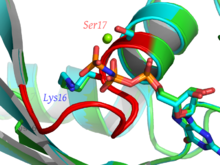- Walker motifs
-
The Walker A and Walker B motifs are protein sequence motifs. These were first reported in ATP-binding proteins by Walker and co-workers in 1982.[1]
Contents
Walker A motif
Walker A motif, also known as the Walker loop or P-loop (phosphate-binding loop) is a motif in proteins. The motif has the pattern GXXXXGK(T/S), where G, K, T and S denote glycine, lysine, threonine and serine residues respectively, and X denotes any amino acid. It is an ATP or GTP binding motif found in many nucleotide-binding proteins. The lysine (K) residue in the Walker A motif is crucial for nucleotide-binding.[2] It is a glycine-rich loop preceded by a beta sheet and followed by an alpha helix. It interacts with the phosphate groups of the nucleotide and with a magnesium ion, which coordinates the β- and γ-phosphates.
Walker A motif is best known for its presence in nucleotide-binding proteins, but is also found in a variety of proteins with widely varying functions, including the alpha and beta subunits of ATP synthase, myosin, transducin, helicases, kinases and RecA.[3][4][5]
Upon nucleotide hydrolysis the loop does not significantly change conformation, but stays bound to the remaining phosphate groups. Walker motif A-binding has been shown to cause structural changes in the bound nucleotide, along the line of the induced fit model of enzyme binding.
PTPs (protein tyrosine phosphatases) that catalyse the hydrolysis of an inorganic phosphate from a phosphotyrosine residue (the reverse of a tyrosine kinase reaction) also contain a motif which folds into a P-loop-like structure. The conserved sequence of this motif is CXXXXXR(S/T), where C and R denote cysteine and arginine residues respectively.[6]
A-loop
The A-loop (Aromatic residue interacting with the Adenine ring of ATP) is a conserved subdomain of aromatic amino acids, found approximately 25 amino acids upstream of the Walker A motif.[7] This subdomain is essential for ATP-binding.
Walker B motif
Walker B motif is a motif in proteins. Walker et al reported the consensus sequence of this motif to be (R/K)XXXXGXXXXLhhhhD, where R, K, G, L and D denote arginine, lysine, glycine, L leucine, and aspartic acid residues respectively, X represents any of the 20 standard amino acids and h denotes a hydrophobic amino acid.[1] The consensus sequence of this motif was more recently reported by Hanson et al. to be hhhhDE, where E denotes a glutamate residue.[2] The aspartate and glutamate also form a part of the DEAD/DEAH motifs found in helicases. The aspartate residue co-ordinates magnesium ions, and the glutamate is essential for ATP hydrolysis.[2]
There is considerable variability in the sequence of this motif, with the only invariant features being a negatively charged residue following a stretch of bulky, hydrophobic amino acids.[8]
See also
References
- ^ a b Walker JE, Saraste M, Runswick MJ, Gay NJ (1982). "Distantly related sequences in the alpha- and beta-subunits of ATP synthase, myosin, kinases and other ATP-requiring enzymes and a common nucleotide binding fold". EMBO J. 1 (8): 945–51. PMC 553140. PMID 6329717. http://www.pubmedcentral.nih.gov/articlerender.fcgi?tool=pmcentrez&artid=553140.
- ^ a b c Hanson PI, Whiteheart SW (July 2005). "AAA+ proteins: have engine, will work". Nat. Rev. Mol. Cell Biol. 6 (7): 519–29. doi:10.1038/nrm1684. PMID 16072036.
- ^ Stryer, Lubert; Berg, Jeremy Mark; Tymoczko, John L. (2002). Biochemistry. San Francisco: W.H. Freeman. ISBN 0-7167-4684-0.
- ^ Ramakrishnan, C; Dani, VS; Ramasarma (October 2002). "A conformational analysis of Walker motif A [GXXXXGKT (S)] in nucleotide-binding and other proteins". Protein Engineering 15 (10): 783–798. doi:10.1093/protein/15.10.783. PMID 12468712. http://peds.oxfordjournals.org/cgi/content/full/15/10/783.
- ^ Saraste M, Sibbald PR, Wittinghofer A (November 1990). "The P-loop--a common motif in ATP- and GTP-binding proteins". Trends Biochem. Sci. 15 (11): 430–4. PMID 2126155.
- ^ Zhang M, Stauffacher CV, Lin D, Van Etten RL (August 1998). "Crystal structure of a human low molecular weight phosphotyrosyl phosphatase. Implications for substrate specificity". J. Biol. Chem. 273 (34): 21714–20. doi:10.1074/jbc.273.34.21714. PMID 9705307.
- ^ Ambudkar SV, Kim IW, Xia D, Sauna ZE (February 2006). "The A-loop, a novel conserved aromatic acid subdomain upstream of the Walker A motif in ABC transporters, is critical for ATP binding". FEBS Lett. 580 (4): 1049–55. doi:10.1016/j.febslet.2005.12.051. PMID 16412422.
- ^ Koonin EV (June 1993). "A common set of conserved motifs in a vast variety of putative nucleic acid-dependent ATPases including MCM proteins involved in the initiation of eukaryotic DNA replication". Nucleic Acids Res. 21 (11): 2541–7. doi:10.1093/nar/21.11.2541. PMC 309579. PMID 8332451. http://www.pubmedcentral.nih.gov/articlerender.fcgi?tool=pmcentrez&artid=309579.
External links
Categories:- Protein structural motifs
Wikimedia Foundation. 2010.

